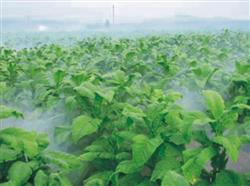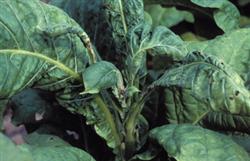How to use pesticides in growing tobacco?

How to use pesticides in growing tobacco? Please introduce the methods of growing tobacco and using pesticides can refer to the following methods: 1. Adhere to the principle of "unity". First, unified pesticide management, that is, recommendation opinions are formed by provincial (bureau) companies with comprehensive consideration of the safety, effect, price and other factors of tobacco pesticides, and unified examination, approval and procurement by state (city) companies. according to the occurrence characteristics of diseases and insect pests in local tobacco areas, all county-level companies put forward local procurement plans according to the list of varieties recommended by provincial companies, and the branches shall strictly examine and approve and carry out unified procurement. Stop the use of banned pesticides in tobacco from the source, so that the management of tobacco pesticide use can be substantially standardized. Second, unified comprehensive prevention, according to the occurrence characteristics of major local diseases and insect pests, unify the time and dosage of pesticide application, organize planting teams to carry out centralized control, and improve the effect of large area control. 2. adhere to the principle of "safety". Tobacco is a leaf crop, the toxicity and residue of pesticides should be taken into account when selecting pesticides, and pesticides with high efficiency, low toxicity and low residues are generally selected. 3. Adhere to the principle of "symptomatic". Different types of pesticides, the scope and object of prevention and control are also different, therefore, it is necessary to achieve symptomatic use of drugs. In order to avoid unnecessary loss and waste caused by blind drug use, the types of diseases and pests must be correctly diagnosed before application, and then the right medicine can be given full play to the prevention and control effect of the drug. 4. Adhere to the principle of "effectiveness". The use of pesticides is not as much as possible. increasing the dosage and frequency of pesticides at will will not only increase the cost, but also easily cause drug damage to tobacco and aggravate pollution. under the action of high concentration and high dose, the drug resistance of pests and pathogens is enhanced, which brings potential danger to the future control. When dispensing, the concentration of the agent should be accurate, and in strict accordance with the requirements in the manual, the pesticide should be diluted to an appropriate concentration with water, so that the agent can be dispersed evenly and fully dissolved in the water. If the concentration is too high, it will not only cause waste, but also cause drug damage; if the concentration is too low, the control effect will not be achieved. 5. Adhere to the principle of "limitation". It is necessary to strictly control the time and frequency of pesticide application, too early, can not play the role of preventing diseases and insects, but cause waste; too late, the occurrence of diseases and pests entered the peak, drug resistance increased. Therefore, in order to achieve the purpose of less drug use and good effect, we must use medicine in an appropriate time according to the occurrence law of diseases and insect pests, treat early and small, and control the harm in time. The spraying times are mainly determined according to the residual period and climatic conditions. For most fungicides, they are generally sprayed every 10 to 15 days for 2 to 3 times. Spray should be in windless weather, spray in time in case of rain after spraying. Pesticides that decompose easily in strong light should be applied on cloudy days or in the evening as far as possible. Do not use any pesticides on rainy days or before rain. 6. Adhere to the principle of "appropriate". The application method should be appropriate, and the application method should be selected according to the law of diseases and insect pests, the harmful position and the description of pesticides. Root irrigation can be used for soil-borne diseases, and spray control can be used for wind-borne diseases or aboveground pests. 7. Stick to the original test "in place". Be sure to make sure that the spraying site is accurate, there are often two problems in the spraying process: one is to spray from head to foot regardless of etiology and focus; the other is to spray only the front of the leaf while ignoring the back of the leaf. Therefore, when spraying, the correct spraying site should be determined according to the characteristics of disease and insect activity and the stage of onset. 8. Adhere to the principle of "prudence". In the operation of pesticide application, incorrect selection of chemicals, improper application methods and excessive dosage, high concentration, too many times of application and too short interval are easy to produce drug damage, resulting in abnormal physiology and even death of tobacco plants. Mild drug damage can be traced to quick-acting fertilizer, irrigation or leaching to accelerate the growth of tobacco plants, which can be alleviated in a short time, while serious ones are not easy to save. Therefore, the use of medicine should be cautious. In addition, different types of pesticides should be applied alternately. If a single pesticide is used for a long time, it will lead to drug resistance of diseases and insect pests, thus reducing the control effect. 9. Adhere to the principle of "guidance". The preparation and mixed use of chemicals must be carried out under the guidance of technicians. In particular, attention should be paid to the analysis, understanding of their respective properties and determination of whether they can be mixed or not. only reasonable mixing can play a role in both treatment and synergism. 10. Adhere to the "green" principle. All kinds of pesticides are toxic to human beings and animals, so it is necessary to do a good job in safety protection during application to ensure safe application. Do not apply pesticides with high residues and serious environmental pollution. Waste pesticide packaging must be unified and centralized disposal, do not litter in the field, so as not to cause pollution. Click to get more tobacco planting techniques click to get more flower planting techniques
- Prev

What pesticides can be used in tobacco leaves?
What pesticides can be used in tobacco leaves? Please introduce the main pesticides commonly used in tobacco are dimethoate, omethoate, aldicarb, aldicarb, endosulfan, carbaryl, trichlorfon, S-fenvalerate and cyhalothrin.
- Next

What are the symptoms of tobacco pesticide damage?
What are the symptoms of tobacco pesticide damage? Please introduce the symptoms of tobacco pesticide damage such as yellowing of leaves, severe leaf spots, wilting, burns, dwarfing, slow growth, deformities and even wilt or death of tobacco plants. The occurrence of such symptoms is called drug damage. The crops affected by drug damage can be divided into acute drug damage and slow drug damage according to different symptoms.
Related
- Fuxing push coffee new agricultural production and marketing class: lack of small-scale processing plants
- Jujube rice field leisure farm deep ploughing Yilan for five years to create a space for organic food and play
- Nongyu Farm-A trial of organic papaya for brave women with advanced technology
- Four points for attention in the prevention and control of diseases and insect pests of edible fungi
- How to add nutrient solution to Edible Fungi
- Is there any good way to control edible fungus mites?
- Open Inoculation Technology of Edible Fungi
- Is there any clever way to use fertilizer for edible fungus in winter?
- What agents are used to kill the pathogens of edible fungi in the mushroom shed?
- Rapid drying of Edible Fungi

